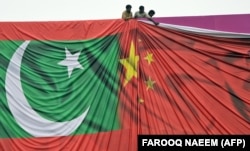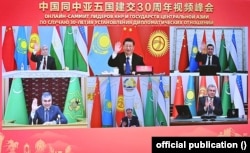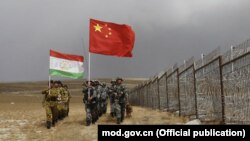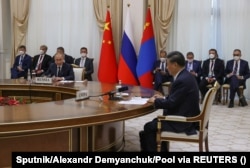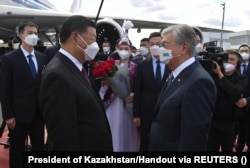
Pakistan is the country in the world that is the most influenced by China, according to a new study that measures Beijing's expanding global sway.
The China Index -- a database relaunched on December 8 by Doublethink Lab, a Taiwan-based research organization -- ranks the South Asian country atop a list of 82 other countries around the world, saying that its links to and dependency on Beijing in terms of foreign and domestic policy, technology, and the economy make it particularly susceptible to Chinese influence.
Behind Pakistan, Southeast Asia features prominently in the rankings, with Cambodia and Singapore listed in second and third, followed by Thailand. The Philippines is seventh and Malaysia is 10th. South Africa is the first African country at No. 5, where it is tied with Peru, the highest-ranked South American country.
Kyrgyzstan and Tajikistan, which border China's western Xinjiang Province, are the Central Asian countries most influenced by Beijing, coming in at eighth and ninth place on the index.
Meanwhile, Germany is the highest-ranked European country at 19th and the United States leads North America in 21st position.
"A major goal of [of this database] is to raise awareness around the world about the different aspects of Chinese influence and what that can actually look like," Min Hsuan-Wu, the co-founder and CEO of Doublethink Lab, told RFE/RL. "We've taken a much broader and nuanced look at what influence can be, which can tell us more about what Beijing is actually doing and the different ways it can apply pressure."
In compiling the China Index, the research team focused on nine categories to track influence around the world that include higher education, domestic politics, economic ties, foreign policy, law enforcement, media, military cooperation, cultural links, and technology.
Wu says that this type of system leads to a more subtle understanding that challenges some assumptions about the levers of Chinese influence, most crucially around economics and trade.
"There's no one clear pattern for how China influences a country, but from the data we compiled, the economy isn't the determinative one," he said. "You can be economically independent but be tied in other ways, like with the military or a large Chinese diaspora that can be more influential."
Spotlight On Pakistan, Central Asia
Given the diverse factors shaping the ranking system, Pakistan's leading position is no surprise to longtime observers of the country's relationship with Beijing, which was forged in the early days of the Cold War.
The South Asian country is home to the China-Pakistan Economic Corridor, a centerpiece of Beijing's globe-spanning Belt and Road Initiative in which Chinese entities have funded and built hundreds of billions of dollars' worth of infrastructure projects in the last decade.
Pakistan's ties with China, however, have ballooned across nearly every category used to compile its ranking in the index, especially when it comes to areas like military ties, technology, and foreign policy.
Shahzeb Jillani, a veteran journalist who helped compile research on Pakistan used for the database, says that many Pakistanis may be surprised to see their country ranking so high, but he hopes the findings will lead to greater debate and reflection about Islamabad's deepening ties with Beijing.
"One can only hope that this will encourage Pakistanis to debate the pros and cons of the relationship and what it could mean for the future," he said.
Central Asia has also seen its relationship with Beijing expand in recent years.
While trade and investment were an early impetus, Chinese influence now plays a growing role in foreign policy, local media, and increasingly in defense and security. Following Russia's February invasion of Ukraine, many analysts also see Central Asian countries deepening their China ties as they seek to diversify from Moscow.
While Kyrgyzstan and Tajikistan rank in the top 10, Kazakhstan holds 15th place in the rankings, with Uzbekistan in the 24th spot, and Turkmenistan -- which sells a large portion of its natural gas to China but remains geopolitically isolated -- in 45th position.
Measuring Influence
Though the database includes just 82 countries, Doublethink Lab plans to expand it in the future, especially across Africa, another area of rising Chinese influence recently, and to Russia, which declared a "no limits" partnership with Beijing in February.
Wu says he hopes the China Index will be a valuable tool for comparison that can be used by researchers, activists, journalists, and watchdog groups around the world to get a better snapshot of the complex factors affecting their regions and the nuanced ways influence can be exercised.
For instance, Britain is ranked the second-highest European country, 27th on the index. It is something that Martin Thorley, an independent academic who did research on the United Kingdom for the database, says is the result of local engagement through academia and ties forged between British cities and regions with their Chinese counterparts over the years, rather than at the state level.
Wu adds that it's hard to discern exactly how one country gets influenced more than another and that there's no definitive "playbook" for Chinese influence. Rather, he says the recent research shows that Chinese policymakers tend to target certain countries within a region that have a lower barrier to entry and then branch outwards to neighbors based on the opportunities available.
"There are some countries in every region that rank high on our index and can be seen as an entry point," Wu said. "There's lots of collaboration through one country and then it expands out."




